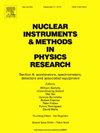Design of a large-scale superconducting dipole magnet for the CEE spectrometer
IF 1.5
3区 物理与天体物理
Q3 INSTRUMENTS & INSTRUMENTATION
Nuclear Instruments & Methods in Physics Research Section A-accelerators Spectrometers Detectors and Associated Equipment
Pub Date : 2025-02-16
DOI:10.1016/j.nima.2025.170324
引用次数: 0
Abstract
The CSR External-target Experiment (CEE) is a large-scale spectrometer under construction at the Heavy Ion Research Facility in Lanzhou (HIRFL) for studying the phase structure of nuclear matter at high baryon density and the equation of states of nuclear matter at supra-saturation densities. One of the key components is a large acceptance dipole magnet with a central field of 5000 Gauss and the homogeneity of 5% within a 1 m long, 1.2 m wide, and 0.9 m high aperture. Detectors will be installed within this aperture. An innovative design for the superconducting detector magnet that goes beyond the conventional approach is proposed. The magnet is designed as a coil-dominant type, with conductors discretized on a racetrack-shaped cross-section to generate the necessary fields. A warm iron yoke is used to enhance the central field and minimize the stray field. The magnet has overall dimensions of 3.4 m in length, 2.7 m in height, and 4.3 m in width. The coils will be wound using a 19-strand rope cable comprised of 12 NbTi superconducting wires and 7 copper wires. The ratio of copper to superconductor of the cable is 6.9. The keel supports serve as the primary structural support for the coils to withstand the electromagnetic force. The superconducting coils will be indirectly cooled by liquid helium within three external helium vessels. To ensure reliable protection of the magnet during a quench, an active protection method combined with a quench-back effect is employed. This paper presents a detailed design of the magnetic field, structure, quench protection, and cryostat for the spectrometer magnet.
求助全文
约1分钟内获得全文
求助全文
来源期刊
CiteScore
3.20
自引率
21.40%
发文量
787
审稿时长
1 months
期刊介绍:
Section A of Nuclear Instruments and Methods in Physics Research publishes papers on design, manufacturing and performance of scientific instruments with an emphasis on large scale facilities. This includes the development of particle accelerators, ion sources, beam transport systems and target arrangements as well as the use of secondary phenomena such as synchrotron radiation and free electron lasers. It also includes all types of instrumentation for the detection and spectrometry of radiations from high energy processes and nuclear decays, as well as instrumentation for experiments at nuclear reactors. Specialized electronics for nuclear and other types of spectrometry as well as computerization of measurements and control systems in this area also find their place in the A section.
Theoretical as well as experimental papers are accepted.

 求助内容:
求助内容: 应助结果提醒方式:
应助结果提醒方式:


